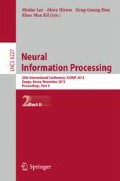Abstract
Deep learning methods that comprise a new class of learning algorithms give state-of-the-art performance. We propose a novel methodology to learn deep architectures and refer to it as a deep relational machine (DRM). A DRM learns the first layer of representation by inducing first order Horn clauses and the successive layers are generated by utilizing restricted Boltzmann machines. It is characterised by its ability to capture structural and relational information contained in data. To evaluate our approach, we apply it to challenging problems including protein fold recognition and detection of toxic and mutagenic compounds. The experimental results demonstrate that our technique substantially outperforms all other approaches in the study.
Access this chapter
Tax calculation will be finalised at checkout
Purchases are for personal use only
Preview
Unable to display preview. Download preview PDF.
References
Hinton, G.E., Salkhutdinov, R.: Reducing the dimensionality of data with Neural Networks. Science 33, 504–507 (2006)
Bengio, Y., Lamblin, P., Popovici, D., Larochelle, H.: Greedy layer-wise training of deep networks. In: Adv. in Neu. Infor. Processing Systems 19, pp. 153–160. MIT Press (2007)
McCarthy, J.: Programs with common sense. In: Proc. of Teddington Conf. on the Mechanization of Thought Processes, pp. 75–91. Her Majesty’s Stationery Office, London (1959)
Kramer, S., Lavrac, N., Flach, P.: Propositionalisation approaches to Relational Data Mining. In: Dzeroski, S., Larac, N. (eds.) Relational Data Mining, pp. 262–291. Springer, Berlin (2001)
Muggleton, S., Lodhi, H., Amini, A., Sternberg, M.J.E.: Support Vector Inductive Logic Programming. In: Hoffmann, A., Motoda, H., Scheffer, T. (eds.) DS 2005. LNCS (LNAI), vol. 3735, pp. 163–175. Springer, Heidelberg (2005)
Landwehr, N., Passerini, A., Raedt, L., Frasconi, P.: kFOIL: Learning simple relational kernels. In: Proc. of the Nat. Conf. on Artificial Intelligence (AAAI), vol. 21, pp. 389–394 (2006)
Ackley, D.H., Hinton, G.E., Sejnowski, T.J.: A learning algorithm for Boltzmann machines. Cognitive. Sci. (9), 147–169 (1985)
Laer, W.V., de Raedt, L., Dzeroski, S.: On multi-class problems and discretization in Iductive Logic Programming. In: Proc. of the 10th Int. Symposium on Foundations of Intelligent Systems, pp. 277–286 (1997)
Lodhi, H., Muggleton, S., Sternberg, M.J.E.: Learning large margin first order decision lists for multi-class classification. In: Gama, J., Costa, V.S., Jorge, A.M., Brazdil, P.B. (eds.) DS 2009. LNCS, vol. 5808, pp. 168–183. Springer, Heidelberg (2009)
Ding, C.H., Dubchak, I.: Multi-class protein fold recognition using support vector machines and neural networks. Bioinformatics 17, 349–358 (2001)
Debnath, A.K., de Compadre, R.L.L., Debnath, G., Schusterman, A.J., Hansch, C.: Structure-activity relationship of mutagenic aromatic and heteroaromatics nito compounds. correlation with molecular orbital energies and hydrophobicity. J. Med. Chem. 34(2), 786–797 (1991)
Richard, A., Williams, C.: Distributed structure-searchable toxicity (DSSTox) public database network: A proposal. Mutat. Res. 499(1), 27–52 (2002)
Cootes, A.P., Muggleton, S., Sternberg, M.J.: The automatic discovery of structural principles describing protein fold space. J. Mol. Biol. 330(4), 839–850 (2003)
Author information
Authors and Affiliations
Editor information
Editors and Affiliations
Rights and permissions
Copyright information
© 2013 Springer-Verlag Berlin Heidelberg
About this paper
Cite this paper
Lodhi, H. (2013). Deep Relational Machines. In: Lee, M., Hirose, A., Hou, ZG., Kil, R.M. (eds) Neural Information Processing. ICONIP 2013. Lecture Notes in Computer Science, vol 8227. Springer, Berlin, Heidelberg. https://doi.org/10.1007/978-3-642-42042-9_27
Download citation
DOI: https://doi.org/10.1007/978-3-642-42042-9_27
Publisher Name: Springer, Berlin, Heidelberg
Print ISBN: 978-3-642-42041-2
Online ISBN: 978-3-642-42042-9
eBook Packages: Computer ScienceComputer Science (R0)

